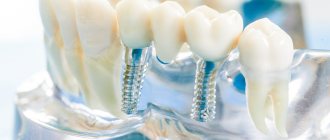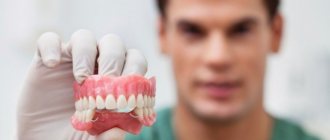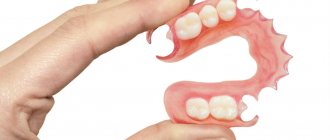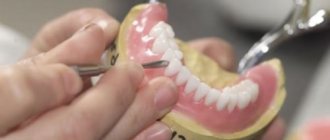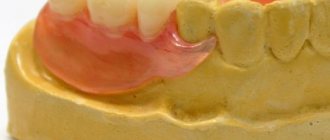Poor fixation of removable dentures is one of the common problems faced by patients. Despite the fact that orthopedists have come up with options for reliable fastening of the structure in the oral cavity, a universal method suitable for everyone without exception has not appeared.
There are several options for the instability of prostheses - immediately after installation and after some time of use. Initial instability is a consequence of improperly selected removable dentures and adjustment of the product to the alveolar process.
Reasons for unsatisfactory fastening
In order for the patient to adapt to the new structures as quickly as possible, experts recommend not removing them even during sleep (despite pain and discomfort in the gum area). As a rule, adaptation to the prosthesis and a tight fit to the crest of the alveoli is achieved 3 weeks after installation.
Sometimes cases occur when a tightly fixed product begins to wobble. The reason of that:
- Unprofessional adjustment of the base - the lower dentition often suffers. This is due to the fact that the jaw is involved in speaking and chewing food. Due to constant mobility, the structure may move from its original location.
- Lack of supporting teeth - if there is one supporting tooth, the fixation weakens over time.
- Anatomical and physiological features of the dentofacial apparatus - incorrect arrangement of teeth, a small amount of bone tissue, etc.
- Incorrectly selected method of fastening - methods such as clasps (wire hooks), screw elements, magnets, attachments (locks), pelots are used for fixation. For each patient, the type of fastening is selected according to individual parameters.
- Looseness of the supporting teeth is observed both before and after fixation of the prosthesis. At the same time, not only molars, but also bridge-like products can become loose. The reason for this is the destruction of the fastening cement.
Repair, correction, relining of full-arch removable dentures
All inaccurately made full dentures can cause various lesions of the oral mucosa and inflammatory growth, so repairing, adjusting and relining dentures in such cases is very important.
Repair
A fracture of the prosthesis can occur either during its use or when it hits a hard surface. Thus, the key point of repair will be the exact matching and connection of the broken parts in the original position.
Median fractures
Causes
- Absence or insufficient relief in the midline
- Resorption of alveolar ridges
Procedure
The broken parts are matched and fixed with sticky wax on the polished surface
- The matching of parts can be strengthened using pins or plastic sticks
- Any undercuts on the contacting surfaces are isolated with wax or plaster
- Gypsum is poured onto the contacting surface. After the plaster has cured, the prosthesis is removed from the model and cleaned of wax residues.
- The edges of the fracture are excised, expanded by 8-10 mm along the fracture line and beveled towards the polished surface to expand the adhesion area
- For a more durable bond, dovetail cuts can be applied to the fracture line.
- The model is painted with the middle part demarcated, then the prosthesis is attached to the model using rubber clamps
- Self-curing resin is applied to the modified fracture line until all voids are filled. The area of the median palatal suture is unloaded.
- If necessary, make corrections
- Rework in some situations
Breakdowns in various parts
Main reasons
Hitting the ground or sink when cleaning
Types
- Floor without defects (repair as described above)
- Floor with part missing
Procedure
- An impression is taken when the prosthesis is inserted into the oral cavity.
- After casting the model, the defect is filled with wax or self-hardening plastic, restoring the lost part. This is followed by packing, replacement, curing, grinding and polishing.
Breakage with fracture or loss of teeth
- Broken teeth are cut with burs
- A sufficient amount of plastic is removed from the lingual side and dovetail cuts are made.
- Teeth of similar shape, size and shade are placed in the correct position and fixed with base wax
- A “key” is made from plaster to register and maintain the position of teeth
- Teeth to be repaired are removed with all surrounding wax
- Subsequently, the teeth are set according to the plaster “key”
- Self-hardening resin is applied from the lingual side until the defect area is completely filled. The surface is covered with thin foil
- After curing, the “key” is removed, the prosthesis is ground and polished
Correction of a complete removable denture
Prosthesis correction refers to manipulations that lead to greater tissue adaptation to the prosthesis by adding new material to the contacting surface without changing the occlusal relationship.
It is used in cases where the prosthesis loses good fixation or adaptation to the underlying tissues, while all other factors, such as occlusion, aesthetics, centric relation, and the basis of the prosthesis remain satisfactory.
- Loss of retention
- Instability
- Food under the denture
- Damaged mucosa
General terms
- Optimal condition of the underlying tissues
- Correctly installed lateral and central occlusion
- Adequate peripheral expansion
Procedure
The patient is forced not to wear the prosthesis for 48 hours to allow the mucous membrane to recover and reduce inflammation due to improper fit of the structure.
Prosthesis correction
- Any undercuts on the base are removed
- Side edges are checked and adjusted
- The edges are rounded and smoothed, and the space is also prepared for filling with new material.
- A hole is made on the palatal side so that excess impression material can come out through it.
- A new impression is taken in centric occlusion and correct occlusal relationship
- A plaster model is cast using the new impression.
- The denture is removed, the old base is carefully cleaned
- The new plastic is packaged and the prosthesis is cured in a setting with water at 45 degrees for 20 minutes. This mode prevents the porosity of the material and its deterioration (releasing internal stress)
- Manual grinding and polishing of the prosthesis is carried out
Relocation
This is the process of readapting the prosthesis to the underlying tissues by replacing the base without changing the occlusal relationship
Indications
When the existing base is of unsatisfactory quality, damaged or has pores
Procedure
- An impression is made using the existing prosthesis, then the model is cast
- Occlusal and incisal indices are established using a duplicator, areas duplicating the lower teeth are attached to the upper teeth to obtain an accurate jaw relationship
- The denture with impression material is removed from the model
- The artificial teeth are separated from the denture and all base material is removed (porcelain teeth are removed under high temperature)
- The teeth are placed and held in the correct position in the index model using adhesive wax on the labial and buccal surfaces
- A sheet of base wax is placed along the edge of the model
- The top of the duplicator closes and the artificial teeth are positioned in the correct position
- The model is deleted and cleared
- After cleaning, the model is attached to the top of the duplicator to check the occlusal relationship
- The occlusion of the relined prosthesis is subsequently corrected in the oral cavity
Author: Dr. Jaouadi Jamila
Consequences of loose dentures
Failure to see a doctor in a timely manner to correct the problem can cause serious complications that become more noticeable to others:
- Rubbing and injury to periodontal tissues, leading to inflammatory processes and periodontitis;
- discomfort while eating;
- distorted speech;
- change in facial proportions;
- Gastrointestinal diseases associated with poor chewing of food.
In addition, delaying a visit to the dentist can provoke the appearance of purulent abscesses, which subsequently require surgical intervention.
How to glue a dental crown
It should be noted that the stage of fixing the crown is as important as all other stages of prosthetics. Incorrect fixation can cost the patient a tooth and will simply nullify all the efforts of the doctor and the patient. Therefore, one of the main tasks when installing a crown will be reliable sealing of the crown, stability and long-lasting results. The doctor will need to ensure that the fixation holds the result of the prosthesis for as long as possible without any discomfort for the patient.
How is the crown fixed?
A special cement is used as an adhesive for crowns. There are different types of cement, which are selected depending on whether the crown is temporary or permanent, and what material it is made of. The cement must have the same optical characteristics as the prosthesis in terms of its structure. In each specific clinical case, the dentist selects the optimal material. The cement used to fix the prosthesis is absolutely safe for the tissues with which it comes into contact.
To secure the crown with cement, the tooth must be ground down to the desired thickness. The crown is then carefully treated with cement and inserted into the tooth. In this case, the prosthesis should stand in the same way as in previous fittings. Excess cement that appears at the base of the prosthesis must be removed before hardening occurs. Insufficiently thorough treatment of cement residues leads to gum trauma. Upon completion of the procedure, the cement is irradiated with a special light to harden and finally secure the crown. The patient may feel tightness in the teeth, this feeling goes away after 40 minutes. Discomfort and whitening in the gum area will also disappear after 10 minutes.
After proper fixation, the cement protects against moisture and food getting under the crown. It is highly durable and protects teeth from caries by releasing fluoride. Proper fixation allows the crown to last for decades. Permanent cement holds the prosthesis so tightly that removal of the crown is only possible using a special device or sawing.
What to do if the crown falls out
The question of how to glue a dental crown is more pressing than ever if the denture suddenly falls out. This can happen for various reasons, for example, due to a loose fit of the crown to the tooth. Often the crown falls out when eating food. In such cases, you should not panic. The first thing to do is save the crown. It needs to be washed and placed in a cool, safe place. After this, you should contact your dentist to report the problem and schedule an appointment. It is important not to delay your visit to the doctor, as if the denture is not put back in as soon as possible, the tooth may break or move.
Before seeing a doctor, it is recommended to try to insert the crown back. If the prosthesis does not fit securely, there is dental cement available at the pharmacy that will help in this matter. To insert a crown, you need to carefully clean it along with the tooth using a toothbrush. Next, you need to dry the tooth and denture by wiping them with sterile gauze. A small amount of dental cement is then applied to the crown. After fixing the crown, gently squeeze the jaw. The denture should not interfere and be higher than the rest of the teeth. If everything is done correctly, the crown will feel the same as before it fell out. After this, you will need to remove excess cement from the gums and tooth and wait for it to harden.
Under no circumstances should you use household glue to glue the crown. If a denture is lost, the patient can apply dental cement to the top of the tooth to relieve discomfort. But it’s better to quickly see a doctor, he will install the crown in place.
French dentists at French Dental Clinic will help you even in the most delicate situation. If a patient addresses the problem of a fallen crown, he will very soon have an appointment with an experienced and attentive orthopedist who will solve this problem without unnecessary difficulties.
Healthy teeth and good health
FDC will be a pleasant find for you and your family on the path to impeccable aesthetics and good health.
Options for getting out of the current situation
The problem is resolved on an individual basis, taking into account the client’s personal wishes and financial capabilities. Corrective methods include: relining the structure, replacing components, implanting dentures, manufacturing a more advanced structure. Magnetic fixation, adjustment or replacement of fixation mechanisms are also often used.
An important point is that after 3-5 years, even the most expensive products need replacement or adjustment. Timely replacement is the right solution for those who want to have a wonderful smile without huge financial costs.
Recommendations for use
| Click to sign up for a FREE consultation |
The service life of each product directly depends on the source materials, operating conditions and variety. Thus, the service life of an acrylic structure is about 5 years, clasp systems - up to 10 years.
An important aspect is the storage of the prosthesis. It is recommended to store rubber products in water at night, as this prevents their deformation; more modern acrylic and nylon prostheses do not need to be removed at all (if you want to take a break from the prosthesis, the structure can be removed, cleaned and placed in a special case). If you have not worn a removable denture for a long time, it should be treated with an antiseptic before installation.
The main rule for long-term use of a removable denture is regular visits to the doctor. Don't forget to visit the dentist at least once a year.
The denture sticks, but falls off when chewing, what should I do?
Gentlemen, only a dentist can help in this matter. The removable denture should be tightly suctioned and not fall off during chewing, especially the upper one. When a person puts on the teeth, they stick, but after facial movements with the lips and cheeks the prosthesis slips, then probably the edge, the border is long, the soft tissues, when moving, pull the structure down, pressing on the elongated plastic. Here you need to carefully sharpen the elongated edge. If the dressed and suctioned teeth fall off when chewing, then the reasons are: on the contrary, the shortened border of the new removable denture and secondly, the not entirely accurate contact of the plastic teeth with the teeth of the lower jaw. When the upper full denture is in the mouth, even if it has a shortened border, it will usually stick (I note, conditionally stick), but if you put a load on it, it will inevitably fall off. During life, a person independently learns to hold a removable denture, which is made with shortened borders.
Is there a solution? The decision to see a dentist. Gentlemen, a dentist can lengthen a denture. Moreover, it is better to do this if the dentist transfers the collapsed structure to a dental technician, this specialist in the dental laboratory will do everything in the highest quality manner.
What if the cause of teeth slipping when chewing is premature contact on one tooth?
How to understand this? When closing the mouth and closing the dentition, there is immediately one contact, premature, which the person acutely feels, paying attention to it, and then the jaws slide into multiple contacts. The dentist, using carbon paper, finds and uses the plastic tooth correction method to achieve, together with the patient, a comfortable closing of the mouth. The person clearly indicates a comfortable closing of the mouth.
What else can cause the denture to lift up when chewing?
When talking with a patient about the rules for using removable dentures, it is imperative to talk about chewing food on both sides at the same time! The whistling structure can be subjected to a one-sided load and it overturns, lifts, or moves from its original place.
This question is important, since the standard of living due to a small situation can change significantly.
The future inner part of a removable denture for the upper jaw with complete absence of teeth, pay attention to the volumetric edge responsible for suction.
What to do if a bridge or crown becomes uncomfortable
It is worth immediately noting that fixed orthopedic structures - crowns and bridges - cannot be modified. If they do not fit well, then either they were made incorrectly, or the bonding cement has broken down - there is still a chance to “save” the prosthesis, but not always. Another option is that the tooth under the crown has begun to decay. In all these cases, the crown or bridge wobbles and falls off. And the patient is prescribed new prosthetics.
Read on the topic: what to do if the dental bridge begins to loosen - useful recommendations for maintaining the beauty and health of your smile.
Next, we will talk about removable orthopedic structures - how to increase the fit and comfort of wearing.
Why does the bridge prosthesis wobble in the mouth - reasons for mobility and how to deal with them?
A bridge is a type of permanent prosthetics supported by your teeth or implants. The supports can be living teeth, pulpless teeth, previously prosthetic teeth, the number of supporting teeth or implants from 2 or more.
The reasons for the mobility of bridges can be different.
The main reason is the mobility of the supporting teeth themselves, which could have existed before the fixation of the bridge prosthesis; mobility may appear during the process of wearing the bridge prosthesis; this occurs due to overload or improper load on the entire prosthesis, that is, a violation of occlusion, malocclusion, which forces all teeth to be overloaded , bad habits of the patient, that is, pathological stress, bruxism (teeth grinding).
Another reason may be a violation of the properties of the fixing cement, due to this, mobility may appear, that is, the cause is decementation. It is also worth noting the period of wearing the prosthesis, that is, if the teeth are under a bridge for more than 10 years, then the appearance of mobility is a normal physiological process, which will increase over the years, since each of these supporting teeth experiences additional load from the missing tooth, this is the main minus bridges. In view of this, modern dentistry tries as much as possible to avoid dental bridges and resorts to implantations. But bridges on implants are something else, since the implant is radically different from the tooth, their mobility can only appear from severe overload (incorrect occlusion) or from poorly performed implantation, as a result of which at the time of loading with their crowns, the implants already had a loss bone tissue.
There is no way to combat mobility if you only use preventive methods, namely regular check-ups with a dentist, and take periodic X-ray photographs. But if there is severe mobility of the bridge, the first thing to do is to remove it, assess the condition of the teeth visually and according to the x-ray image, and perhaps there will be a chance to save some teeth, and remove some. In this case, each clinical situation must be assessed individually. If the mobility is associated with decementation, that is, the properties of the cement have been impaired, then you can either remove and re-fix it (this is very rare), or make a new bridge. Each situation is individual, so if you have a similar situation, then you should not draw conclusions in advance; it is better to consult a dentist and hear his professional opinion.
